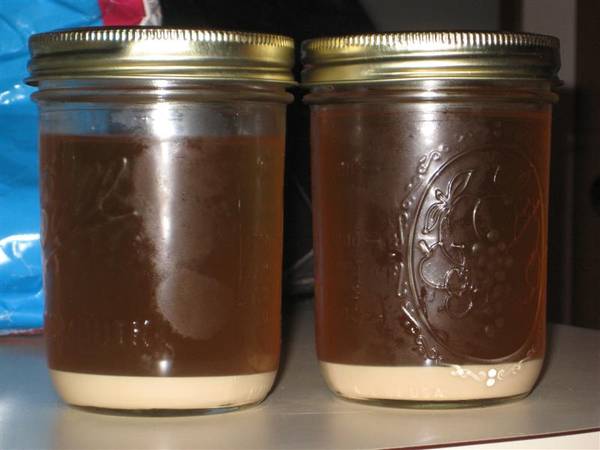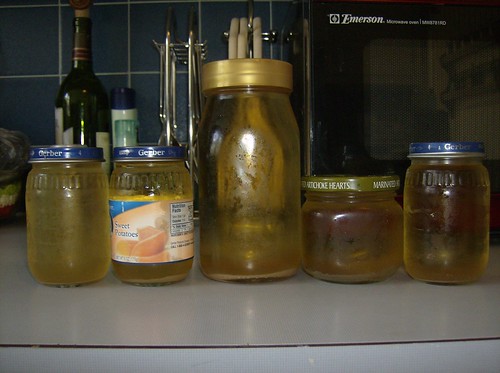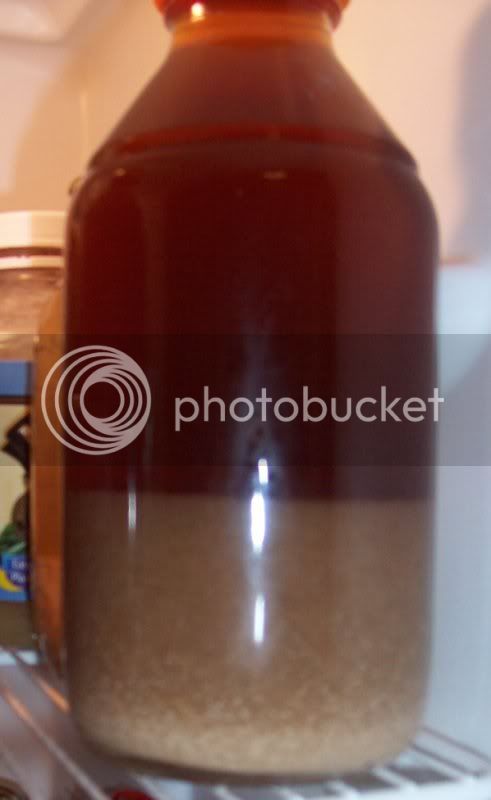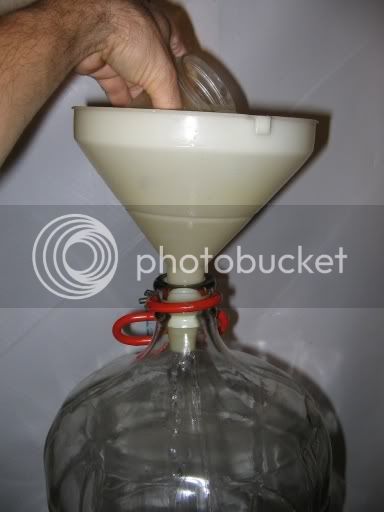chrisbarnes5000
Well-Known Member
Anyboby ever/any reason not to use the shot dispensers you put on a bottle of hard alcohol to drop the trub and other random crap? (Aside from it being just about impossible to clean and sanitize properly.)

Anyboby ever/any reason not to use the shot dispensers you put on a bottle of hard alcohol to drop the trub and other random crap? (Aside from it being just about impossible to clean and sanitize properly.)
You mean the ones where the shots are dispensed from the bottom (ie, the bottle is upside down)? That might be useful.



I am adding this just as a data point for others using this method:
I just used my first "washed yeast" collected using the steps outlined in this thread. The pitched example looked exactly as pictured in OP (the 1/2 pt jar on the right). I estimate that I had about 5ml of slurry.
The yeast was 3 months old (washed on 12/29/08) and pitch on 3/29/09 into a 2 qt starter. It took 18 hrs to show signs of activity (note - no stir plate, just lots of shaking) and was rocking like crazy at 24 hrs.
I pitched at near peak activity (no decanting) into 5.5 gals of oatmeal stout. It started bubbling within 6-8 hours and was pushing out the blow tube sometime between 10-18 hrs from pitching (basically sometime during the night).
I am anxous the see the final Attentuation numbers, but expect they will be on the low side given the nature of the grain bill.
Thanks to Bernie Brewer for posting this!!!!

Good to know. Just this past weekend I decided spur-of-the-moment to brew a ~1.068 Stout...I just pitched 2 washed/decanted half-pint mason jars of washed yeast...one of which was 3 month old WLP004 (the other was 1 month old Wyeast Pacman yeast). Both of these jars had a good 30mL of 'cake' so, depending on viability, should be a decent amount. It took off slower than normal (took about 24 hours) but it's chugging like crazy now.UPDATE:
ATT = 74% (WLP-004). That's 3 month old yeast. According to Mr. Malty viability should have been around 10% with my sample. Probably still under pitched, but it definitely did the job.
peace :rockin:
So regarding the pictures on the sticky...............the far right is what the final product will look like. When you say pour off most of the liquid and pitch........you want less of the liquid and everything that is settled out, or less of the liquid and try not to disturb the settled stuff? I will be attempting this with my WY3068 in my Apfelwein.

You really want to use the yeast in the primary. That is not a lot of yeast, and it will not be as good as the primary yeast would have been.

Just wondering if anybody has tried these techniques and or has ideas about them...
Proceed as you normally would and wash your yeast down to a pint jar. Let the yeast settle out of solution as will naturally happen. THEN decant the majority of your liquid off and transfer to a baby food jar. The advantage of this is obviously, space.
In a similar vein, you could decant most of the liquid off all of your pint jars of the same yeast strain and transfer the yeast from all of them into one pint jar. This way you have one jar of yeast totally filled with yeast and could pour out some when needed into a batch. Once again, space saver.
In my head, these both sound like great ideas. Usually that means I'm overlooking something. Anybody have thoughts?
I racked my mild today and harvested the yeast. My method: racked the beer, added 2 liters of sterile water, stirred up all the yeast/trub and poured it back into the liter jars. This is my normal practice, I will chill that overnight and usually see three distinct layers: beer on top, yeast, then trub on the bottom. The next morning I will pour the yeast layer into another jar. The yeast is usually noticeable because it is creamy white.
So this time the colors are throwing me.

This has only been in the fridge for a couple hours, but what do you think? Is the white on the bottom yeast or trub? Is the dark stuff yeast? This is wyeast 1968, it tends to be very chunky.
Boil it for about 20 minutes or so. This will sanitize everything as well as get rid of any oxygen in the water, so the yeasties will take a nice long nap. Then remove the jars and lids with the tongs, keeping them full of water.
Pour the water from the jars into the carboy

If I'm washing and brewing/pitching on the same day, how many ounces of suspended yeast solution should I pitch directly into the freshly boiled and cooled wort. I won't have time to make a starter since I will be bottling washing and brewing in a span of about 6 or 7 hours.


I'm doing the same thing and plan on washing before I pitch on the next beer. Pitching on the cake is overpitching, so why not wash it, use part of the yeast now and store the rest?
What's wrong with overpitching?
Scott
What's wrong with overpitching?
Scott
While autolysis may be a boogieman when it comes to home brewing, I would think that it could come into play if you're dumping 2 or 3 beers in a row on the same pile of dead yeast at the bottom of your fermenter.
I'm not saying my tastebuds are good, but I have been doing 3-4 batches back to back on a single cake for years. I don't want to do anything stupid either so I'm intrigued by this discussion. Other than extra trub, I don't see what makes an active yeast cake any different than a starter of the same count of yeasties. Is there something different between the two I don't get?
Scott
Enter your email address to join: